Hi,
I am working on a double helix problem for which I would like determine the equation.
I have been able to find a few hints on other forums (Double helix)but they aren't in parametric form. In am specifically looking to determine the equation similar to picture as shown on the right of the precatenanes image.
I would appreciate any help on this.
Thanks so much
I am working on a double helix problem for which I would like determine the equation.
I have been able to find a few hints on other forums (Double helix)but they aren't in parametric form. In am specifically looking to determine the equation similar to picture as shown on the right of the precatenanes image.
I would appreciate any help on this.
Thanks so much


